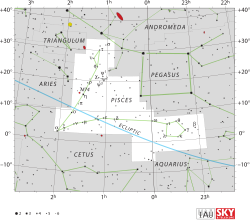Epsilon Piscium
| Observation data Epoch J2000.0 Equinox J2000.0 | |
|---|---|
| Constellation | Pisces |
| Right ascension | 01h 02m 56.60862s[2] |
| Declination | +07° 53′ 24.4855″[2] |
| Apparent magnitude (V) | 4.27[3] |
| Characteristics | |
| Spectral type | K0 III[4] |
| U−B color index | +0.691[3] |
| B−V color index | +0.952[4] |
| Astrometry | |
| Radial velocity (Rv) | +7.47±0.20[4] km/s |
| Proper motion (μ) | RA: −80.17±0.19[2] mas/yr Dec.: +25.59±0.14[2] mas/yr |
| Parallax (π) | 17.94 ± 0.21 mas[2] |
| Distance | 182 ± 2 ly (55.7 ± 0.7 pc) |
| Absolute magnitude (MV) | 0.44[4] |
| Details | |
| Mass | 2.27[4] M☉ |
| Radius | 11.39±0.19[5] R☉ |
| Luminosity | 63.92±1.33[5] L☉ |
| Surface gravity (log g) | 2.99[6] cgs |
| Temperature | 4,834±32[5] K |
| Metallicity [Fe/H] | −0.39[6] dex |
| Age | 2.56[7] Gyr |
| Other designations | |
| Database references | |
| SIMBAD | data |
Epsilon Piscium (Epsilon Psc, ε Piscium, ε Psc) is the Bayer designation for a star approximately 182 light-years (56 parsecs) away from the Earth,[2] in the constellation Pisces. It is a yellow-orange star of the G9 III or K0 III spectral type. This is a giant star, slightly cooler in surface temperature, yet brighter and larger than the Sun.[5] It is a suspected occultation double, with both stars having the same magnitude, separated by 0.25 arcsecond.[8]
Naming
[edit]In Chinese, 外屏 (Wài Píng), meaning Outer Fence, refers to an asterism consisting of ε Piscium, δ Piscium, ζ Piscium, μ Piscium, ν Piscium, ξ Piscium and α Piscium. Consequently, the Chinese name for ε Piscium itself is 外屏二 (Wài Píng èr, English: the Second Star of Outer Fence.)[9] In Japanese, 悠翔星 (Haruto-boshi), meaning "Soaring Forever Star," refers to the Japanese description of ε Piscium.
Planetary system
[edit]In 2021, a gas giant planetary candidate was detected by radial velocity method.[10]
| Companion (in order from star) |
Mass | Semimajor axis (AU) |
Orbital period (days) |
Eccentricity | Inclination | Radius |
|---|---|---|---|---|---|---|
| b (unconfirmed) | >0.77+0.16 −0.10 MJ |
0.88+0.11 −0.10 |
255.3+2.1 −1.4 |
0.278+0.122 −0.186 |
— | — |
References
[edit]- ^ "* eps Psc". SIMBAD. Centre de données astronomiques de Strasbourg. Retrieved October 1, 2007.
- ^ a b c d e f van Leeuwen, F. (2007), "Validation of the new Hipparcos reduction", Astronomy and Astrophysics, 474 (2): 653–664, arXiv:0708.1752, Bibcode:2007A&A...474..653V, doi:10.1051/0004-6361:20078357, S2CID 18759600.
- ^ a b Jennens, P. A.; Helfer, H. L. (September 1975), "A new photometric metal abundance and luminosity calibration for field G and K giants", Monthly Notices of the Royal Astronomical Society, 172 (3): 667–679, Bibcode:1975MNRAS.172..667J, doi:10.1093/mnras/172.3.667.
- ^ a b c d e Hekker, S.; et al. (August 2006), "Precise radial velocities of giant stars. I. Stable stars", Astronomy and Astrophysics, 454 (3): 943–949, arXiv:astro-ph/0604502, Bibcode:2006A&A...454..943H, doi:10.1051/0004-6361:20064946, S2CID 119529768
- ^ a b c d Baines, Ellyn K.; Blomquist, Solvay; Clark III, James H.; Gorney, Jim; Maier, Erin; Sanborn, Jason; Schmitt, Henrique R.; Stone, Jordan M.; van Belle, Gerard T.; Braun, Kaspar von (2023-01-09), "Simultaneous Six-way Observations from the Navy Precision Optical Interferometer", The Astronomical Journal, 165 (2): 41, Bibcode:2023AJ....165...41B, doi:10.3847/1538-3881/aca277, ISSN 0004-6256
- ^ a b Soubiran, C.; et al. (June 2010), "The PASTEL catalogue of stellar parameters", Astronomy and Astrophysics, 515: A111, arXiv:1004.1069, Bibcode:2010A&A...515A.111S, doi:10.1051/0004-6361/201014247, S2CID 118362423.
- ^ Luck, R. Earle (2015), "Abundances in the Local Region. I. G and K Giants", The Astronomical Journal, 150 (3): 88, arXiv:1507.01466, Bibcode:2015AJ....150...88L, doi:10.1088/0004-6256/150/3/88, S2CID 118505114.
- ^ "VizieR Detailed Page". Retrieved October 1, 2007.
- ^ (in Chinese) AEEA (Activities of Exhibition and Education in Astronomy) 天文教育資訊網 2006 年 5 月 19 日 Archived 2016-03-03 at the Wayback Machine
- ^ a b Teng, Huan-Yu; Sato, Bun'ei; Takarada, Takuya; Omiya, Masashi; Harakawa, Hiroki; Izumiura, Hideyuki; Kambe, Eiji; Takeda, Yoichi; Yoshida, Michitoshi; Itoh, Yoichi; Ando, Hiroyasu; Kokubo, Eiichiro (2022), "Regular radial velocity variations in nine G- and K-type giant stars: Eight planets and one planet candidate", Publications of the Astronomical Society of Japan, 74: 92–127, arXiv:2112.07169, doi:10.1093/pasj/psab112

